外研版(2019)必修第二册Unit4 History and traditions过去分词作定语和宾语补足语课件(共21张PPT)
文档属性
| 名称 | 外研版(2019)必修第二册Unit4 History and traditions过去分词作定语和宾语补足语课件(共21张PPT) | 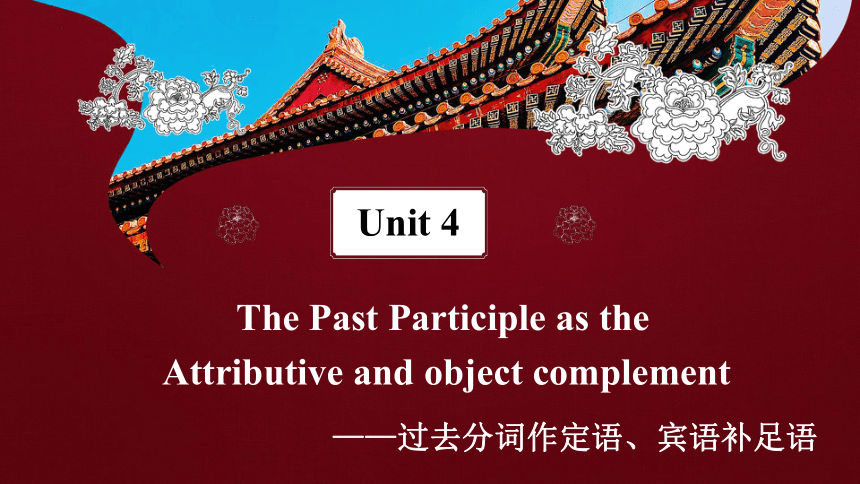 | |
| 格式 | zip | ||
| 文件大小 | 4.9MB | ||
| 资源类型 | 教案 | ||
| 版本资源 | 人教版(2019) | ||
| 科目 | 英语 | ||
| 更新时间 | 2023-03-23 12:30:17 | ||
图片预览

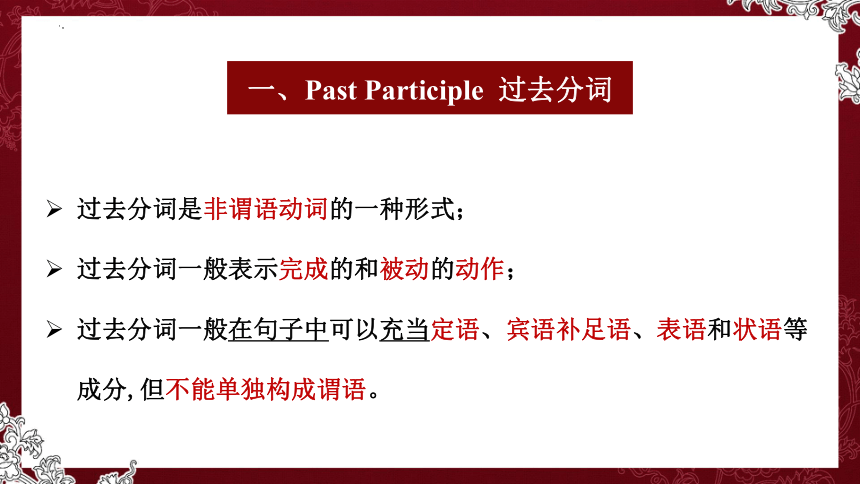
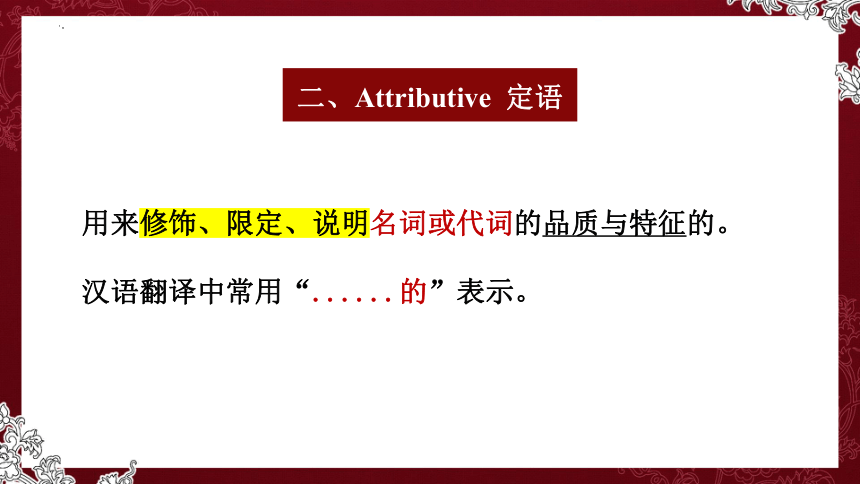

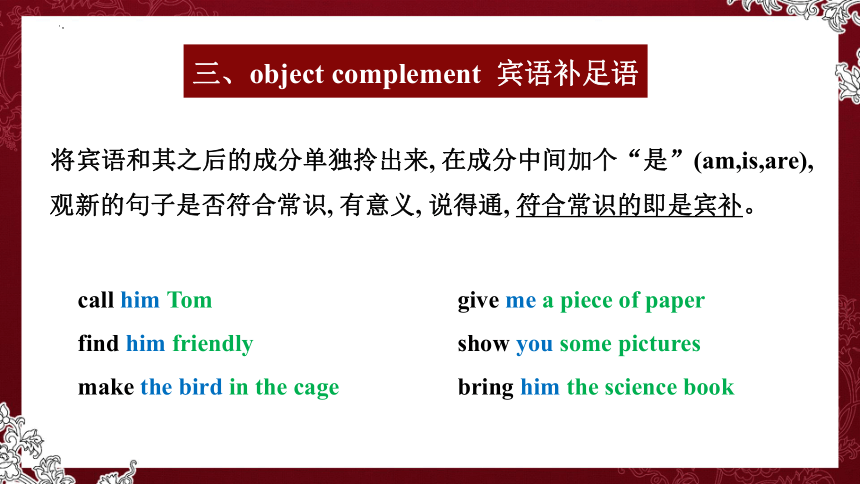
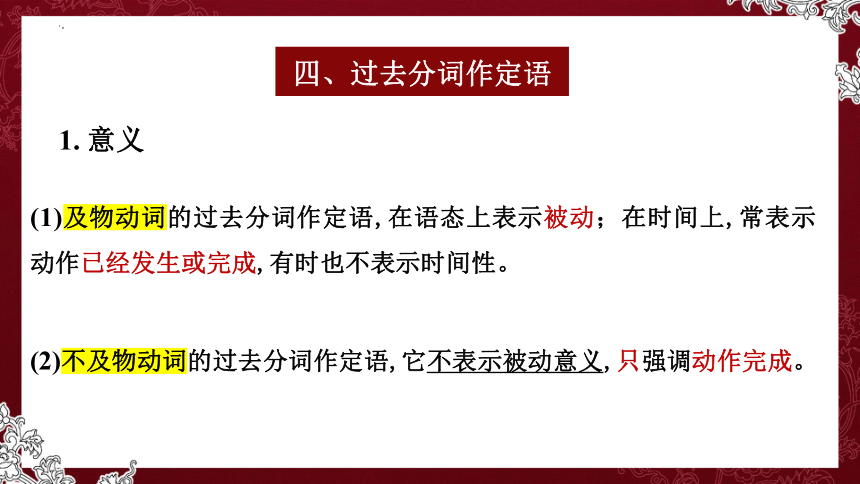
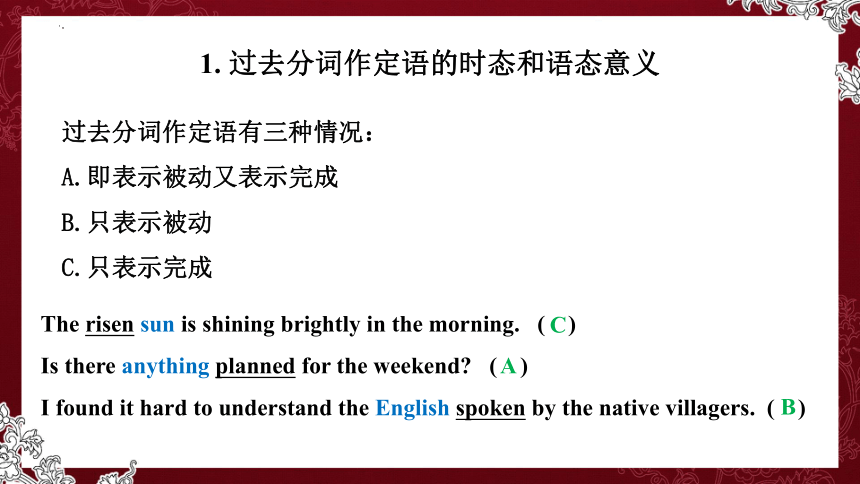
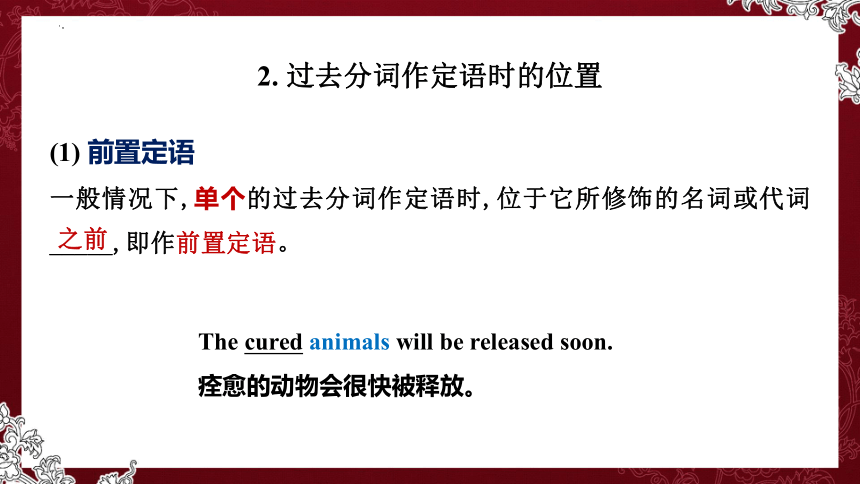
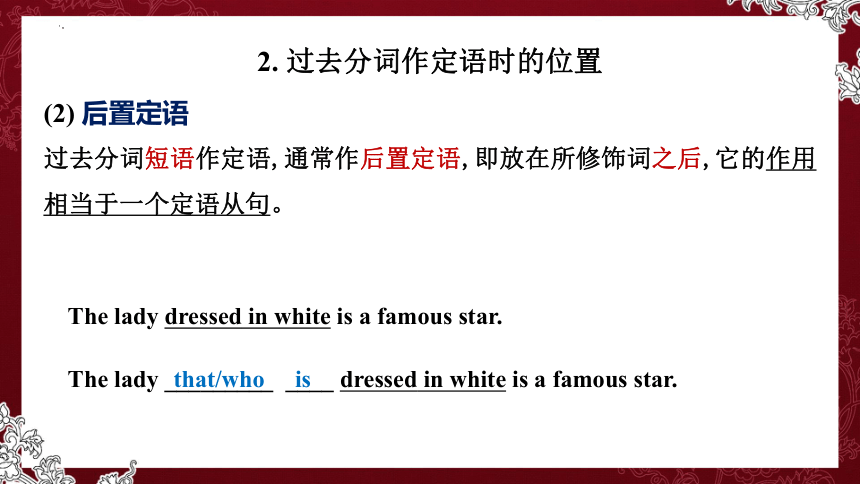
文档简介
(共21张PPT)
The Past Participle as the
Attributive and object complement
Unit 4
——过去分词作定语、宾语补足语
过去分词是非谓语动词的一种形式;
过去分词一般表示完成的和被动的动作;
过去分词一般在句子中可以充当定语、宾语补足语、表语和状语等成分,但不能单独构成谓语。
一、Past Participle 过去分词
用来修饰、限定、说明名词或代词的品质与特征的。
汉语翻译中常用“......的”表示。
二、Attributive 定语
object complement
宾语补足语
带有宾语补足语的一般句型为:
+
+
宾语补足语
Everyone calls him Tom.
宾语
宾补
主语
谓语
宾语补足语一般放在宾语______, 对宾语起__________的作用。
之后
补充说明
某些及物动词
宾语
三、object complement 宾语补足语
object complement
宾语补足语
三、object complement 宾语补足语
将宾语和其之后的成分单独拎出来, 在成分中间加个“是”(am,is,are), 观新的句子是否符合常识, 有意义, 说得通, 符合常识的即是宾补。
call him Tom
find him friendly
make the bird in the cage
give me a piece of paper
show you some pictures
bring him the science book
四、过去分词作定语
(1)及物动词的过去分词作定语,在语态上表示被动;在时间上,常表示动作已经发生或完成,有时也不表示时间性。
(2)不及物动词的过去分词作定语,它不表示被动意义,只强调动作完成。
1. 意义
The risen sun is shining brightly in the morning. ( )
Is there anything planned for the weekend ( )
I found it hard to understand the English spoken by the native villagers. ( )
过去分词作定语有三种情况:
即表示被动又表示完成
只表示被动
只表示完成
1. 过去分词作定语的时态和语态意义
C
A
B
2. 过去分词作定语时的位置
(1) 前置定语
一般情况下,单个的过去分词作定语时,位于它所修饰的名词或代词_____,即作前置定语。
之前
The cured animals will be released soon.
痊愈的动物会很快被释放。
(2) 后置定语
过去分词短语作定语,通常作后置定语,即放在所修饰词之后,它的作用相当于一个定语从句。
The lady _________ ____ dressed in white is a famous star.
The lady dressed in white is a famous star.
that/who is
2. 过去分词作定语时的位置
(3)当过去分词是像state-owned, heart-felt, hand-made等这样的复合形式,或者前面有副词修饰时,一般放在被修饰词前面作前置定语。
2. 过去分词作定语时的位置
(4)有些过去分词表示特定含义时,单独作定语放在所修饰的名词之后,如left(剩余的), given(所给的), concerned(有关的)等。
There are few tigers left. It is time for the departments concerned to take measures to protect them from dying out.
剩余的老虎不多了,是相关当局采取措施保护它们免遭灭绝的时候了。
2. 过去分词作定语时的位置
(5)如果被修饰的词是由every/some/any/no与thing/body/one所构成的复合代词或指示代词those等,单个分词放在被修饰词的后面。
Is there anything unsolved
还有什么没解决的吗?
2. 过去分词作定语时的位置
五、过去分词用作宾语补足语
常见的过去分词作宾补的情况:
I find my money stolen.
He watched the balloon blown away.
I saw an old man knocked down by a car.
1. 用于表示感觉和心理状态的动词,即感官动词后作宾语补足语,如:see, look, observe, watch, hear, listen, feel, think, find, notice。
2. 用于表示“使”“令”“让”等意义的使役动词后作宾补,如:make, get, have, help, keep, leave。
You’d better keep the guests seated.
We're having our car repaired.
I'm trying to get this article finished for Thursday.
make/get/have/keep/leave + 宾语 + done
总结起来,其结构为:
常见的过去分词作宾补的情况
常见的过去分词作宾补的情况
He won’t like such questions discussed at the meeting.
I want the suit made to his own measure.
3. 表示“意愿、命令或者希望”等意义的动词后也常跟过去分词作宾语补足语,如:want, would like, wish, expect, order 等可用过去分词作宾语补足语。
want/would like/wish/expect/order + (to be) + done
All afternoon he worked with the door locked.
With water heated, we can see the steam.
With the matter settled, we all went home.
4. 介词with后可接过去分词作宾语补足语,构成with复合结构“with+宾语+宾补”,这一结构中,过去分词与宾语之间是动宾关系。
常见的过去分词作宾补的情况
Summary
V-ed在句中可作 _____、_____________。
定语
宾语补足语
①单个的过去分词作定语时, 位于它所修饰的名词或代词前面。
② 过去分词短语作定语: 通常后置, 其作用相当于定语从句。
③单个的过去分词修饰复合不定代词something, everything等或指示代词those时, 要放在这些词的后面。
V-ed作宾语补足语通常用于:
①表示感观、感觉和发觉的动词。
②表示“致使、意愿、命令或者希望”意义的动词。
③with的复合结构。
作定语
作宾补
1. Most people just use the shortened name …
2. They use the same flag, known as the Union Jack, …
3. They had castles built all around England, …
4. The United Kingdom, Great Britain, England-many people are confused by…
5. They conquered England after the well-known Battle of Hastings in the 11th century.
作定语
作定语
作宾补
作定语
作定语
判断下面画线部分在句子中做什么成分。
1. Loch Ness was surrounded by beautiful natural landscape, which made it look amazing.
2. Carl and his friends stayed with a generous family who offered them bread with butter and honey that was homemade.
Rewrite the sentences with past participles as the attribute.
Loch Ness surrounded by beautiful natural landscape looks amazing.
Carl and his friends stayed with a generous family who offered them homemade bread with butter and honey.
3. The family's ancestors once attended to soldiers who were wounded in the First World War.
4. The young people were attracted by the legend of Loch Ness. They watched over the lake with their cameras and binoculars, which were positioned on the hill.
The family's ancestors once attended to wounded soldiers in the First World War.
The young people attracted by the legend of Loch Ness watched over the lake with their cameras and binoculars positioned on the hill.
THANKS
The Past Participle as the
Attributive and object complement
Unit 4
——过去分词作定语、宾语补足语
过去分词是非谓语动词的一种形式;
过去分词一般表示完成的和被动的动作;
过去分词一般在句子中可以充当定语、宾语补足语、表语和状语等成分,但不能单独构成谓语。
一、Past Participle 过去分词
用来修饰、限定、说明名词或代词的品质与特征的。
汉语翻译中常用“......的”表示。
二、Attributive 定语
object complement
宾语补足语
带有宾语补足语的一般句型为:
+
+
宾语补足语
Everyone calls him Tom.
宾语
宾补
主语
谓语
宾语补足语一般放在宾语______, 对宾语起__________的作用。
之后
补充说明
某些及物动词
宾语
三、object complement 宾语补足语
object complement
宾语补足语
三、object complement 宾语补足语
将宾语和其之后的成分单独拎出来, 在成分中间加个“是”(am,is,are), 观新的句子是否符合常识, 有意义, 说得通, 符合常识的即是宾补。
call him Tom
find him friendly
make the bird in the cage
give me a piece of paper
show you some pictures
bring him the science book
四、过去分词作定语
(1)及物动词的过去分词作定语,在语态上表示被动;在时间上,常表示动作已经发生或完成,有时也不表示时间性。
(2)不及物动词的过去分词作定语,它不表示被动意义,只强调动作完成。
1. 意义
The risen sun is shining brightly in the morning. ( )
Is there anything planned for the weekend ( )
I found it hard to understand the English spoken by the native villagers. ( )
过去分词作定语有三种情况:
即表示被动又表示完成
只表示被动
只表示完成
1. 过去分词作定语的时态和语态意义
C
A
B
2. 过去分词作定语时的位置
(1) 前置定语
一般情况下,单个的过去分词作定语时,位于它所修饰的名词或代词_____,即作前置定语。
之前
The cured animals will be released soon.
痊愈的动物会很快被释放。
(2) 后置定语
过去分词短语作定语,通常作后置定语,即放在所修饰词之后,它的作用相当于一个定语从句。
The lady _________ ____ dressed in white is a famous star.
The lady dressed in white is a famous star.
that/who is
2. 过去分词作定语时的位置
(3)当过去分词是像state-owned, heart-felt, hand-made等这样的复合形式,或者前面有副词修饰时,一般放在被修饰词前面作前置定语。
2. 过去分词作定语时的位置
(4)有些过去分词表示特定含义时,单独作定语放在所修饰的名词之后,如left(剩余的), given(所给的), concerned(有关的)等。
There are few tigers left. It is time for the departments concerned to take measures to protect them from dying out.
剩余的老虎不多了,是相关当局采取措施保护它们免遭灭绝的时候了。
2. 过去分词作定语时的位置
(5)如果被修饰的词是由every/some/any/no与thing/body/one所构成的复合代词或指示代词those等,单个分词放在被修饰词的后面。
Is there anything unsolved
还有什么没解决的吗?
2. 过去分词作定语时的位置
五、过去分词用作宾语补足语
常见的过去分词作宾补的情况:
I find my money stolen.
He watched the balloon blown away.
I saw an old man knocked down by a car.
1. 用于表示感觉和心理状态的动词,即感官动词后作宾语补足语,如:see, look, observe, watch, hear, listen, feel, think, find, notice。
2. 用于表示“使”“令”“让”等意义的使役动词后作宾补,如:make, get, have, help, keep, leave。
You’d better keep the guests seated.
We're having our car repaired.
I'm trying to get this article finished for Thursday.
make/get/have/keep/leave + 宾语 + done
总结起来,其结构为:
常见的过去分词作宾补的情况
常见的过去分词作宾补的情况
He won’t like such questions discussed at the meeting.
I want the suit made to his own measure.
3. 表示“意愿、命令或者希望”等意义的动词后也常跟过去分词作宾语补足语,如:want, would like, wish, expect, order 等可用过去分词作宾语补足语。
want/would like/wish/expect/order + (to be) + done
All afternoon he worked with the door locked.
With water heated, we can see the steam.
With the matter settled, we all went home.
4. 介词with后可接过去分词作宾语补足语,构成with复合结构“with+宾语+宾补”,这一结构中,过去分词与宾语之间是动宾关系。
常见的过去分词作宾补的情况
Summary
V-ed在句中可作 _____、_____________。
定语
宾语补足语
①单个的过去分词作定语时, 位于它所修饰的名词或代词前面。
② 过去分词短语作定语: 通常后置, 其作用相当于定语从句。
③单个的过去分词修饰复合不定代词something, everything等或指示代词those时, 要放在这些词的后面。
V-ed作宾语补足语通常用于:
①表示感观、感觉和发觉的动词。
②表示“致使、意愿、命令或者希望”意义的动词。
③with的复合结构。
作定语
作宾补
1. Most people just use the shortened name …
2. They use the same flag, known as the Union Jack, …
3. They had castles built all around England, …
4. The United Kingdom, Great Britain, England-many people are confused by…
5. They conquered England after the well-known Battle of Hastings in the 11th century.
作定语
作定语
作宾补
作定语
作定语
判断下面画线部分在句子中做什么成分。
1. Loch Ness was surrounded by beautiful natural landscape, which made it look amazing.
2. Carl and his friends stayed with a generous family who offered them bread with butter and honey that was homemade.
Rewrite the sentences with past participles as the attribute.
Loch Ness surrounded by beautiful natural landscape looks amazing.
Carl and his friends stayed with a generous family who offered them homemade bread with butter and honey.
3. The family's ancestors once attended to soldiers who were wounded in the First World War.
4. The young people were attracted by the legend of Loch Ness. They watched over the lake with their cameras and binoculars, which were positioned on the hill.
The family's ancestors once attended to wounded soldiers in the First World War.
The young people attracted by the legend of Loch Ness watched over the lake with their cameras and binoculars positioned on the hill.
THANKS
